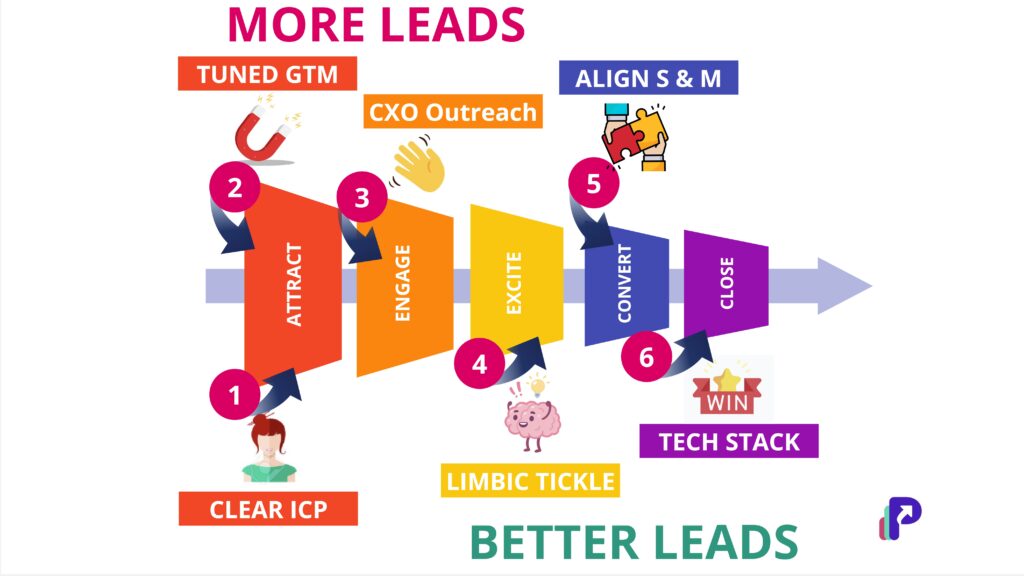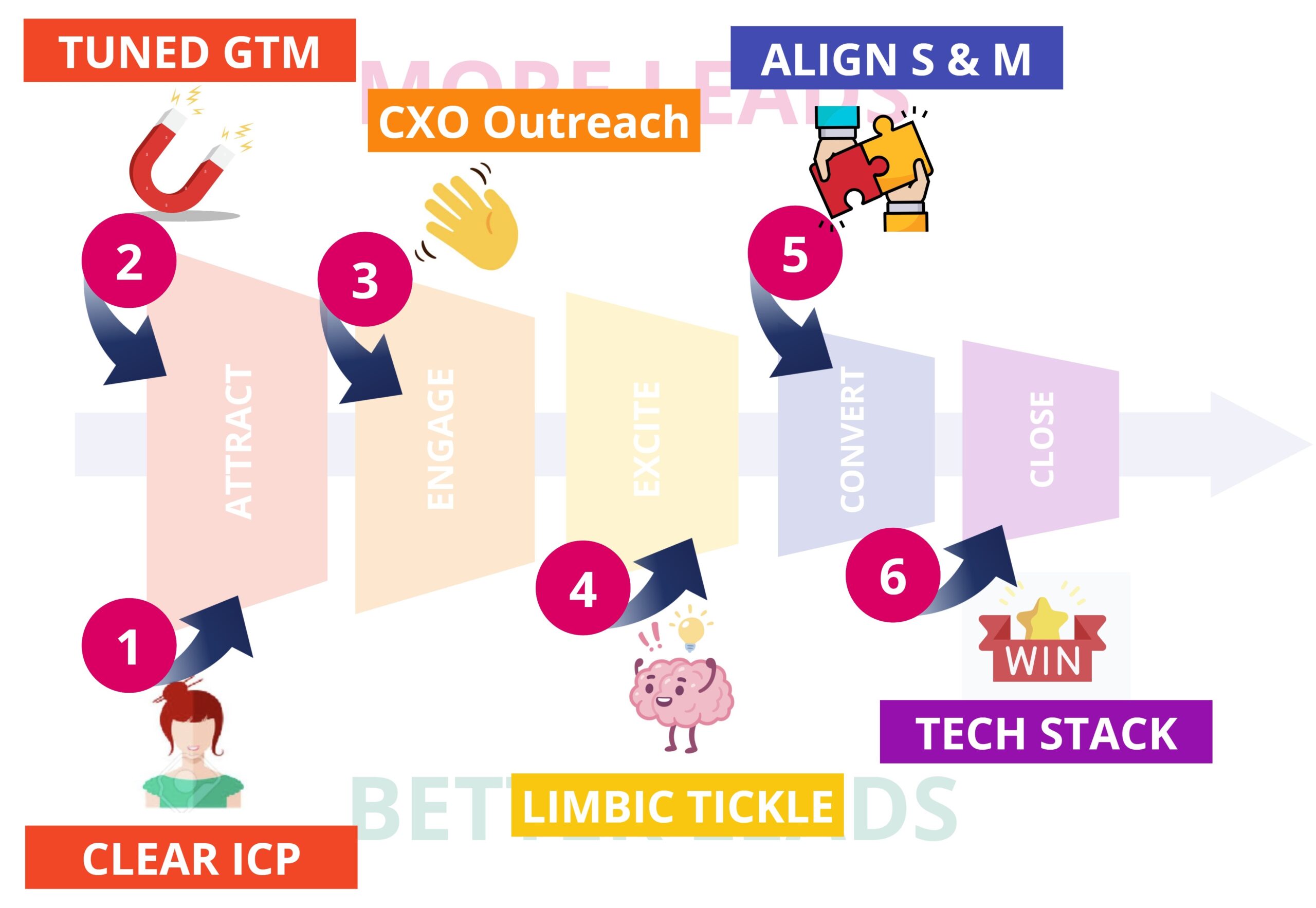CXO Survey: What still works generating B2B pipeline
In the last three years, the market has rendered old standbys for pipeline generation mostly useless: Canned, high volume cold-calling as it was practiced is now dead. Cold emails, BDR “smiling-and-dialing”, or blanket LinkedIn outreaches all stopped yielding meaningful results. Worse, they frustrate their targets. So, to find out what is still working, we surveyed colleagues, new and old and customers, as well as some of our followers online. Here are the resulting insights of what can still or again drive leads.
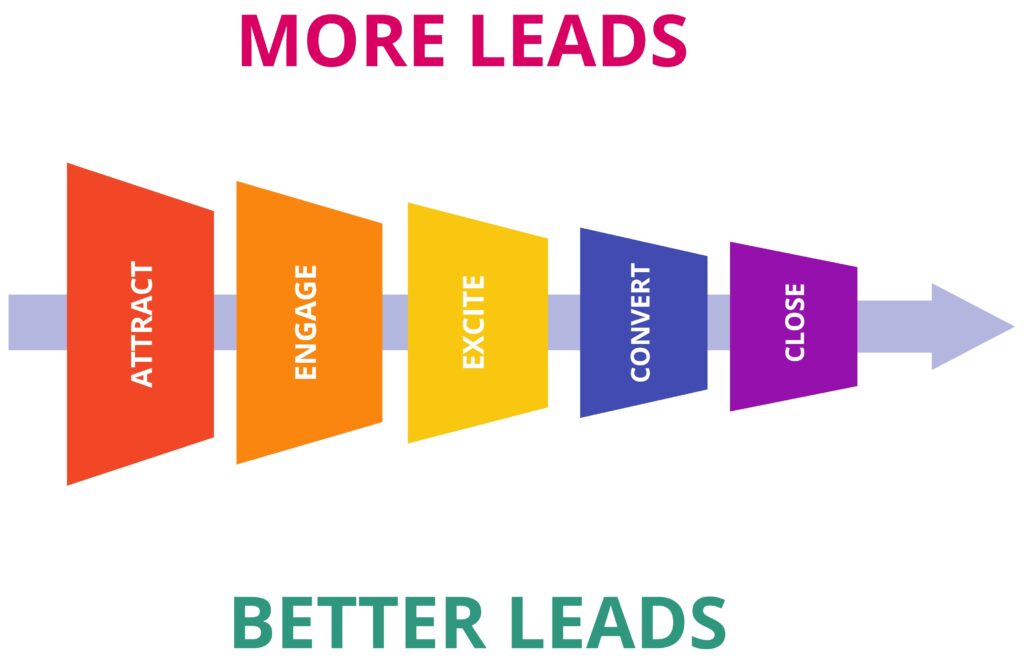
We collected and mapped practical, proven techniques that are in 2023 producing either more or better leads across this typical funnel from attracting leads to closing deals. The resulting ideas that our respondents reported as working for them grouped into six areas with positive impact on pipeline generation.
The first of the six groups is about precisely clarifying the Ideal Customer Profile (“ICP”). Once they know precisely who their ICPs are, then number two is to tune the associated go-to-market. The third area was to leverage their CXOs for customized executive outreach to attract prospects and people in the network. Number four was what we call the “limbic tickle” which refers to creating emotionally engaging outreach vs. the typical corporate / marketing speak. Number five was effectively aligning sales and marketing since most customer journeys now start and end digitally, which implies both functions must cooperate: If marketing does not closely collaborate with sales, entire portions of the sales funnel are lost. Last but not least, number six deals with the need to commensurately modernize their tech stack.
The first set of ideas that our respondents said they’re focusing on to get more and better leads, is arriving at a much richer and more precise definition of their ideal customer profile or ICP. The reason their ICPs need to be refined is that two or three years ago a fairly rudimentary definition may have sufficed to generate leads.
But now, with many fewer prospects in the market, it is more important to more precisely target who actually might still be in the market and who actually has shown a demonstrable record of being interested in their solutions. This required a deep understanding of their customer journeys and problem sets, and the ability to also empathize with their problems to create resonant positioning.
NOTE: In December 2023 we published another blog with our partner firm Telemetry to deep dive into how successful CROs and CMOs are more tightly defining their ICPs, and how that has led to tangible acceleration of B2B pipelines – even now. You can read that new blog here, or if you have no time to read it, then watch our 60 second synopsis here.
Another factor driving a deeper and more precise definition of the ICP was that now many more tools are available that allow much richer assessment of the attributes that characterize a segment of buyers, anything from firmographic attributes like size, verticals, growth rates, or tech stacks. On to demographic attributes of who the prospects are, what’s their level of hierarchy, or what function and title. All the way down to psychographic criteria like, for example, are they innovators or are they laggards, or what are their risk preferences?
Creating a much deeper picture of what prospects care about is being leveraged to target similar classes of prospects that have a demonstrable interest in buying their offerings (which also is reported to lower needed demand generation budgets since conversion rates are higher). So, closely paired with defining the ICP is crisping up the value proposition. A few years ago a one-size-fits-all value proposition that X percent of the market would respond to may have worked. But nowadays, because so many fewer people are in the market, the value proposition is being very closely tuned to the needs and expectations of targeted ICP segments. For more on how to derive a tightly reasoned value proposition read here.
Once ICP and value propositions are clarified, the go-to-market is also being tuned to the matching channels and messaging. What is making a big difference again now are personal introductions and contacts. Which means that most organizations are leveraging referrals, events, and also partners to make introductions to prospects. In markets overcrowded with bland, me-too ads and pitches, to start new relationships requires trust, and that is created through personal referral strategies that leverage professional networks.
Another reason why go-to-markets are being overhauled is that different, targeted personas can be reached in different ways. Decision makers are approached differently than influencers, say, or people from different industries who want to be reached differently. For example, a hospital administrator or a school superintendent is approached with a different go-to-market than, say, CISOs, CFOs, or IT administrators. Therefore, the more precise the ICP definition becomes, the more the associated go-to-market is tuned to their expectations.
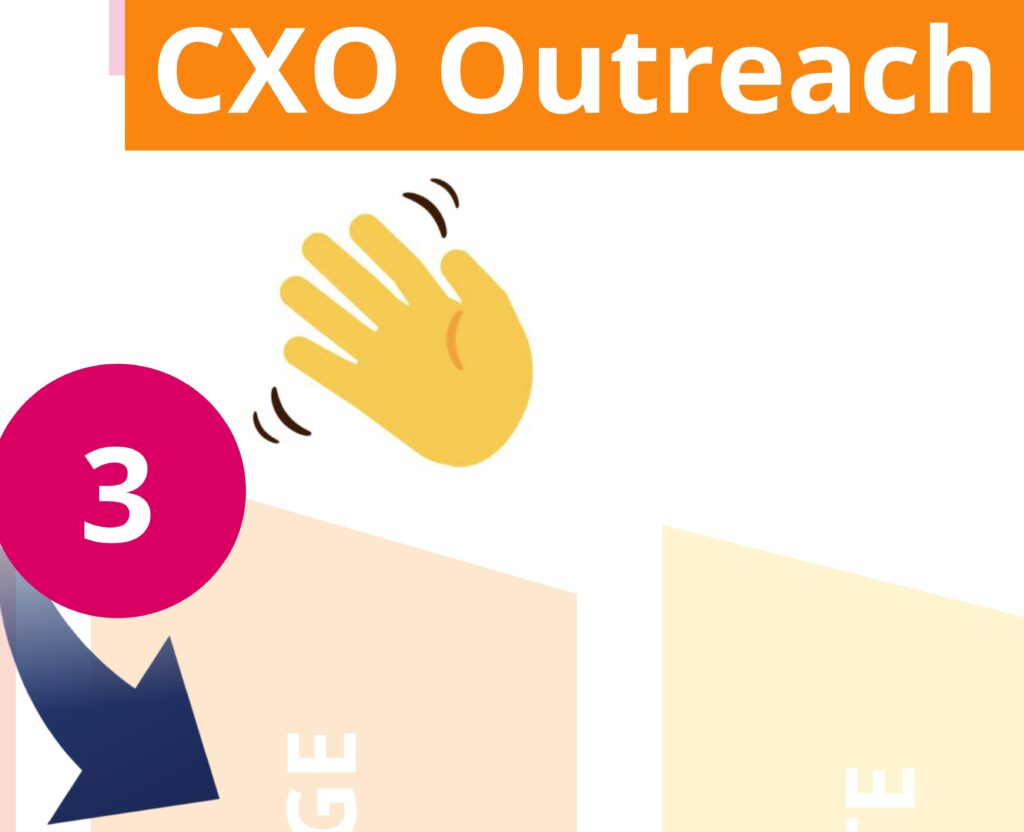
Once ICPs and the go-to-markets are clear, what is now also working is personalized outreach by company executives to targeted prospects. Such personalized outreach should not be selling, but be informative and engaging, attracting prospects to interesting information or questions of mutual interest that the CXOs can then follow up on live. The approach here is to capitalize on executive networks without overly taxing the executive teams, and also leveraging their trust and authority to build new connections.
What is not working anymore is BDR cold-calling, outbound cold emails or LinkedIn invites, and in general, unsolicited messages of any kind. In the current market people are inundated with unsolicited pitches and they’re done with being sold to. They want to be informed and engaged, and maybe interested in a possible solution based on the seller’s deep understanding of their problem – not some canned, spray-and-pray “pitch slapping” that is too blunt and direct.
Number four on the list is what we have named the “limbic tickle”. One of the observable cultural changes of the last couple of years is what we call the “TikTok phenomenon”. People are not interested in lengthy, rational dissertations anymore. They’ll give you five, ten, or maybe 15 seconds to listen to your story, and decide if they want to hear more. They want to be engaged emotionally, not intellectually. We’ve written about this here and here.
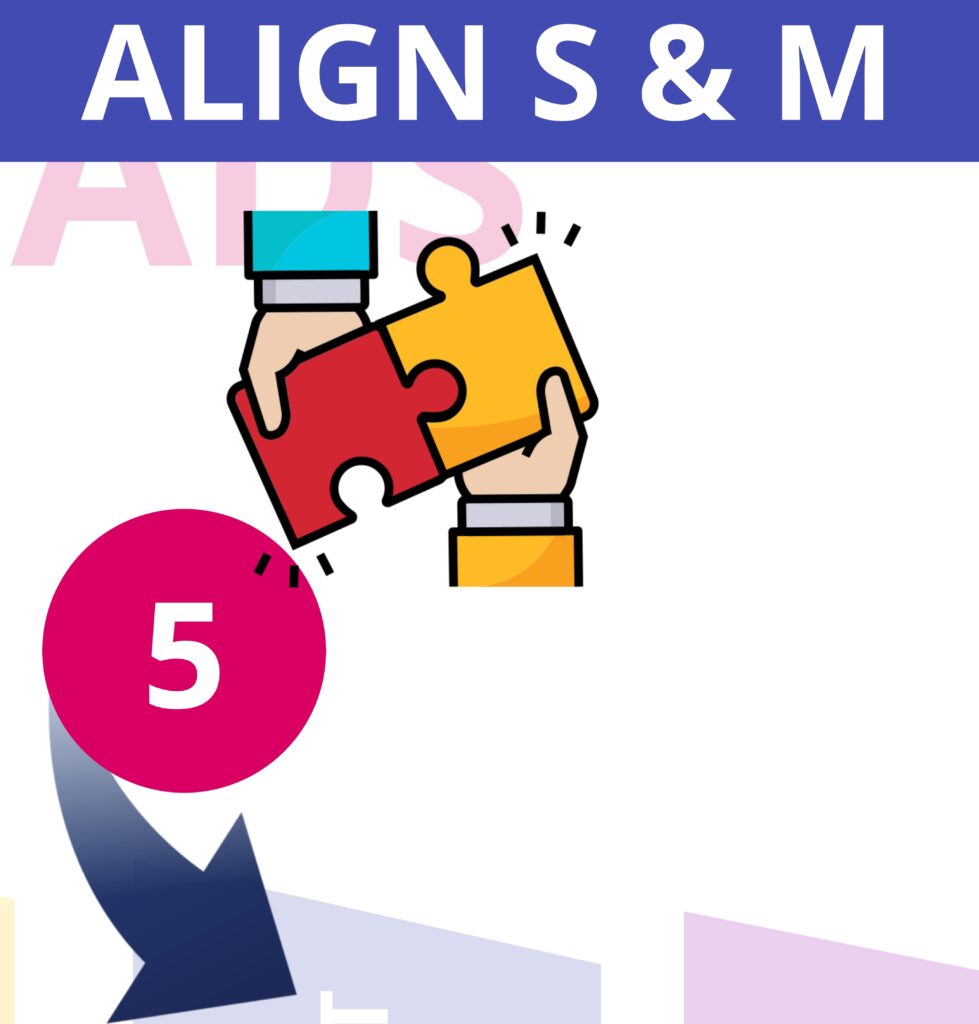
Number five on the list of things that make a difference now is the classic issue of aligning sales and marketing. The reason why this is more important now than before is because most customer journeys start online, which requires sales and marketing to come together to figure out how to excite and engage likely future customers. This requires deep mid-funnel sales enablement, and also that sales and marketing collaborate to translate all that into “limbic tickle” messaging.
PowerPoints and bullet points don’t excite anymore, but compelling, snappy prose that captivates people’s imagination. And with the heightened fiscal scrutiny now, gone are cowboy selling or unaccountable marketing budgets, while managing joint team performance with clear KPIs and success metrics is in. For more on the benefits of aligning sales and marketing is available here
.
The sixth and final area where companies are making changes and getting positive results from is in their tech stacks. Those changes are being implemented for several reasons, one being that it’s important to remove friction from the entire customer journey or sales process. This is especially crucial in the current market when things are slow. The higher the friction and the more complicated the sales process, the less likely are people to complete it. New technologies can help streamline that whole process. We recently published a popular blog on setting up a low-cost tech stack here.
Second, we talked about different go-to-market and different ICPs: Prospects really want to be reached differently and contacted through different venues and mechanisms, which has tech stack implications. As do, last but not least, different go-to-market approaches, such as is there a partner network that requires a different technology implementation? Or do we need to customize outbound messaging at scale to achieve the needed lead volumes and high conversion rates? That can’t be done manually and now requires AI-enabled automation to reduce cost and optimize channel performance.
The resulting, complete set of demand generation techniques that still / again work in 2023 is shown below, superimposed onto our generic lead flow. Go make some money 🙂
